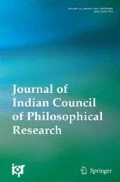Abstract
The article elaborates the notion of darśana from the point of view of some prominent contemporary Indian academic philosophers. After dealing with the two major misconceptions on the concept of darśana, it proposes an alternative approach towards darśana.
Similar content being viewed by others
Notes
Wilhelm Halbfass, India and Europe: An Essay in Philosophical Understanding (Delhi: Motilal Banarsidass, 1990), 265.
T. Ganapati Sastri, Arthaśāstra of Kauṭalya, vol. 1, trans. N.P. Unni (New Delhi: New Bharatiya Book Corporation, 2012), 23–24.
H. Jacobi, Frühgeschichte der Indischen Philosophie. Cited in Halbfass, India and Europe, 274.
Halfbass, India and Europe, 275.
Halfbass, India and Europe, 275.
This term can be equalized with the ability to know what is in future. See Yogasūtra III. 34.
Radhakrishnan, Indian Philosophy, vol. II (Bombay: Blackie & Son Puhlishers, 1977), 18.
Surendranath Dasgupta, A Hisotry of Indian Philosophy, vol.1 (Delhi: Motilal Banarsidass, 1975), 68.
Anna-Pya Sjödin, “Conceptualizing Philosophical Tradition: A Reading of Wilhelm Halbfass, Daya Krishna, and Jitendranath Mohanty,” Philosophy East & West, 61, no. 3, (2011): 534.
M. Hiriyana, Outlines of Indian Philosophy (Delhi: Motilal Banarsidass, 2005), 182.
The method consists of three steps namely śravana (studying the scripture), manana (reflection) and nididhyāsana (contemplation).
J.N. Mohanty, “Some Thought on Daya Krishna’s ‘Three Myths’,” The Philosophy of Daya Krishna, eds. Bhuvan Chandel and K.L. Sharma (New Delhi: Oxford University Press, 1997), 71.
Halbfass, India and Europe, 263.
Halbfass, India and Europe, 2.
Debiprasad Chattopadhyaya, What is Living and What is Dead in Indian Philosophy (New Delhi: People’s Publishing House, 1993), 13.
See Richard V. De Smet, “Guidelines to Indian Philosophy, ch. 6.1: The Sāṃkya-Kārika,” Divyadaan: Journal of Philosophy & Education 23, no. 3 (2012): 427.
“Citta-vṛtti-nirodhaḥ” Yogasūtra I.2.
Mohanty, “Some Thought on Daya Krishna’s ‘Three Myths’,” 72–73.
Daya Krishna, “Comparitve Philosophy: What It Is and What It Ought to Be,” Contrary Thinking: Selected Essays of Daya Krishna, ed. Nalini Bhushan, Jay L. Garfield and Daniel Raveh (New York: Oxford Press, 2011), 61.
Radhakrishnan, Indian Philosophy, 24.
Mohanty, “Some Thought on Daya Krishna’s ‘Three Myths’,” 74.
Mohanty, “Some Thought on Daya Krishna’s ‘Three Myths’,” 72.
Daya Krishna, Indian Philosophy: A Counter Perspective (New Delhi: Oxford University Press, 1997), 15.
Krishna, Indian Philosophy, 39.
Paramparā and sampradāya can be understood as the traditions or sub-traditions. The different traditions of the Vedānta Darśana can be the example for this case.
Radhakrishnan, Indian Philosophy, 769.
See Karl H. Potter, ed., Encyclopedia of Indian Philosophies, vol. 2 (Delhi: Motilal Banarsidass, 1977), 9–12.
Hiriyanna, Outlines of Indian Philosophy, 183–184.
Radhakrishnan, Indian Philosophy, 769.
Hiriyanna, Outlines of Indian Philosophy, 179–180.
Krishna, Indian Philosophy, 13.
Krishna, Indian Philosophy, 13.
Mohanty, “Some Thought on Daya Krishna’s ‘Three Myths’,” 78.
Monier Monier-Williams, A Sanskrit-English Dictionary (New Delhi: Sri Satguru Publications, 2005), s.vv. “saṃ,” “vāda”.
See Daniel Raveh, “On Philosophy as Saṃvāda: Thinking with Daya Krishna,” Philosophy as Saṃvāda and Svarāj: Dialogical Meditations on Daya Krishna and Ramachandra Gandhi, ed. Shail Mayaram (New Delhi: Sage Publications, 2014), 96.
Raveh, “On Philosophy as Saṃvāda: Thinking with Daya Krishna,” 96.
Daniel Raveh, “Text as a process: a dialogue with Daya Krishna,” Exploring the Yogasūtra: Philosophy and Translation (New York: Continuum, 2012), 76.
Author information
Authors and Affiliations
Corresponding author
Additional information
Publisher's Note
Springer Nature remains neutral with regard to jurisdictional claims in published maps and institutional affiliations.
Rights and permissions
About this article
Cite this article
Xavier, C.J. Some Contemporary Views on the Nature of Darśana. J. Indian Counc. Philos. Res. 37, 279–287 (2020). https://doi.org/10.1007/s40961-020-00201-x
Received:
Accepted:
Published:
Issue Date:
DOI: https://doi.org/10.1007/s40961-020-00201-x




